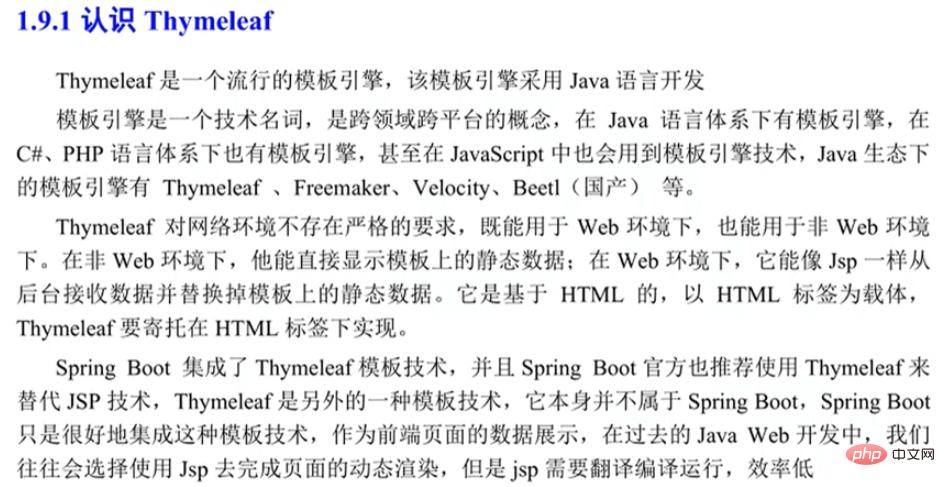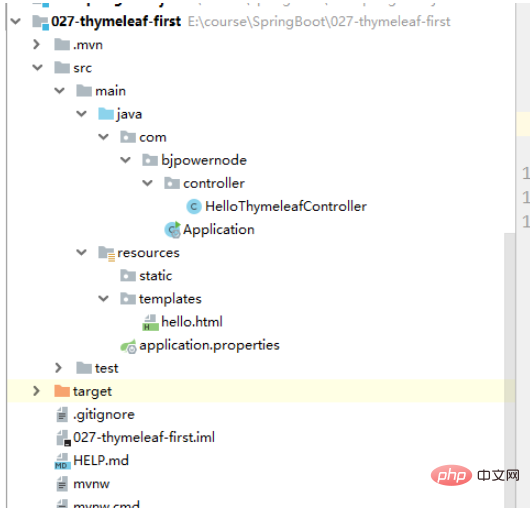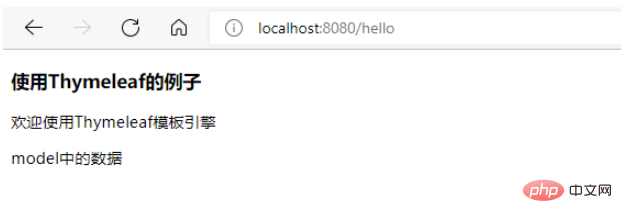SpringBoot Thymeleaf template engine example analysis
Jsp is the earliest template technology, used to process the view layer and use it as a template for data display

B S structure:
B: Browser: used to display data and send requests, without processing capabilities
Send a request and access a.jsp. a.jsp becomes a Servlet on the server side and returns the output data to the browser. You can see the result data in the browser. The jsp is finally translated into an html page.
Template technology, you can use them as string replacements. For example: here {data} here is a string, you put It is replaced by a fixed value and other values, but this replacement has some additional functions, processing the content of the view layer through template technology

First example:

pom.xml: Thymeleaf dependency:
<?xml version="1.0" encoding="UTF-8"?>
<project xmlns="http://maven.apache.org/POM/4.0.0" xmlns:xsi="http://www.w3.org/2001/XMLSchema-instance"
xsi:schemaLocation="http://maven.apache.org/POM/4.0.0 https://maven.apache.org/xsd/maven-4.0.0.xsd">
<modelVersion>4.0.0</modelVersion>
<parent>
<groupId>org.springframework.boot</groupId>
<artifactId>spring-boot-starter-parent</artifactId>
<version>2.7.1</version>
<relativePath/> <!-- lookup parent from repository -->
</parent>
<groupId>com.bjpowernode</groupId>
<artifactId>027-thymeleaf-first</artifactId>
<version>0.0.1-SNAPSHOT</version>
<properties>
<java.version>1.8</java.version>
</properties>
<dependencies>
<!--模板引擎起步依赖-->
<dependency>
<groupId>org.springframework.boot</groupId>
<artifactId>spring-boot-starter-thymeleaf</artifactId>
</dependency>
<!--web起步依赖-->
<dependency>
<groupId>org.springframework.boot</groupId>
<artifactId>spring-boot-starter-web</artifactId>
</dependency>
<dependency>
<groupId>org.springframework.boot</groupId>
<artifactId>spring-boot-starter-test</artifactId>
<scope>test</scope>
</dependency>
</dependencies>
<build>
<plugins>
<plugin>
<groupId>org.springframework.boot</groupId>
<artifactId>spring-boot-maven-plugin</artifactId>
</plugin>
</plugins>
</build>
</project>Create Controller: HelloThymeleafController:
package com.bjpowernode.controller;
import org.springframework.stereotype.Controller;
import org.springframework.web.bind.annotation.RequestMapping;
import javax.servlet.http.HttpServletRequest;
@Controller
public class HelloThymeleafController {
@RequestMapping("/hello")
public String helloThymeleaf(HttpServletRequest request){
//添加数据到request作用域,模板引擎可以从request中获取数据
request.setAttribute("data","欢迎使用Thymeleaf模板引擎");
//指定视图 模板引擎使用的页面(html)
//逻辑名称
return "hello";
}
}templates: used to place view files used in templates , the templates used by the template engine are placed under the template directory:
Create hello.html:
<!DOCTYPE html>
<html lang="en">
<head>
<meta charset="UTF-8">
<title>hello html</title>
</head>
<body>
<h4>使用Thymeleaf的例子</h4>
<!--使用模板th:text=""获取数据-->
<p th:text="${data}">想显示数据</p>
</body>
</html>Run the main startup class Application:
package com.bjpowernode;
import org.springframework.boot.SpringApplication;
import org.springframework.boot.autoconfigure.SpringBootApplication;
@SpringBootApplication
public class Application {
public static void main(String[] args) {
SpringApplication.run(Application.class, args);
}
}Can be found in hello Add to .html: Unresolved th in the tag is very popular, and there is no prompt message when writing
xmlns:th="http://www.thymeleaf.org" In the tag, write th again There will be prompts to record
<!DOCTYPE html>
<html lang="en" xmlns:th="http://www.thymeleaf.org">
<head>
<meta charset="UTF-8">
<title>hello html</title>
</head>
<body>
<h4>使用Thymeleaf的例子</h4>
<!--使用模板th:text="${data}"获取后端request的作用域中的数据,把data数据替换文本,text表示取数据-->
<p th:text="${data}">想显示数据</p>
<p th:text="${data}">显示</p>
</body>
</html>
Use Model:
In Controller:
package com.bjpowernode.controller;
import org.springframework.stereotype.Controller;
import org.springframework.ui.Model;
import org.springframework.web.bind.annotation.RequestMapping;
import javax.servlet.http.HttpServletRequest;
@Controller
public class HelloThymeleafController {
@RequestMapping("/hello")
public String helloThymeleaf(Model model, HttpServletRequest request){
//添加数据到request作用域,模板引擎可以从request中获取数据
request.setAttribute("data","欢迎使用Thymeleaf模板引擎");
//使用model和request作用域是一样的 实际上model中的数据就是放到request作用域中的
model.addAttribute("mydata","model中的数据");
//指定视图 模板引擎使用的页面(html)
//逻辑名称
return "hello";
}
}hello.html:
<!DOCTYPE html>
<html lang="en" xmlns:th="http://www.thymeleaf.org">
<head>
<meta charset="UTF-8">
<title>hello html</title>
</head>
<body>
<h4>使用Thymeleaf的例子</h4>
<!--使用模板th:text="${data}"获取后端request的作用域中的数据,把data数据替换文本,text表示取数据-->
<p th:text="${data}">想显示数据</p>
<p th:text="${mydata}">显示</p>
</body>
</html>
speingboot configuration file application.properties: Commonly used related settings of the template engine. Basically, the settings are default:
# During the development stage, turn off template sending. Cache, let the modification take effect immediately. When set to true, the template cache is used. When accessed for the second time, the data in the memory is used and the template is no longer parsed.
spring.thymeleaf.cache=false
#Encoding Format
spring.thymeleaf.encoding=UTF-8
#Type of template (the default is html, the template is an html file which not only supports web pages as templates but also supports other categories)
spring.thymeleaf.model= HTML
#Template prefix: The default is the classpath of the classpath:/templates directory
spring.thymeleaf.prefix=classpath:/templates/
#Suffix
spring.thymeleaf.suffix=.html
The above is the detailed content of SpringBoot Thymeleaf template engine example analysis. For more information, please follow other related articles on the PHP Chinese website!

Hot AI Tools

Undress AI Tool
Undress images for free

Undresser.AI Undress
AI-powered app for creating realistic nude photos

AI Clothes Remover
Online AI tool for removing clothes from photos.

Clothoff.io
AI clothes remover

Video Face Swap
Swap faces in any video effortlessly with our completely free AI face swap tool!

Hot Article

Hot Tools

Notepad++7.3.1
Easy-to-use and free code editor

SublimeText3 Chinese version
Chinese version, very easy to use

Zend Studio 13.0.1
Powerful PHP integrated development environment

Dreamweaver CS6
Visual web development tools

SublimeText3 Mac version
God-level code editing software (SublimeText3)

Hot Topics
 1794
1794
 16
16
 1740
1740
 56
56
 1591
1591
 29
29
 1474
1474
 72
72
 267
267
 587
587
 How Springboot integrates Jasypt to implement configuration file encryption
Jun 01, 2023 am 08:55 AM
How Springboot integrates Jasypt to implement configuration file encryption
Jun 01, 2023 am 08:55 AM
Introduction to Jasypt Jasypt is a java library that allows a developer to add basic encryption functionality to his/her project with minimal effort and does not require a deep understanding of how encryption works. High security for one-way and two-way encryption. , standards-based encryption technology. Encrypt passwords, text, numbers, binaries... Suitable for integration into Spring-based applications, open API, for use with any JCE provider... Add the following dependency: com.github.ulisesbocchiojasypt-spring-boot-starter2. 1.1Jasypt benefits protect our system security. Even if the code is leaked, the data source can be guaranteed.
 How to use Redis to implement distributed locks in SpringBoot
Jun 03, 2023 am 08:16 AM
How to use Redis to implement distributed locks in SpringBoot
Jun 03, 2023 am 08:16 AM
1. Redis implements distributed lock principle and why distributed locks are needed. Before talking about distributed locks, it is necessary to explain why distributed locks are needed. The opposite of distributed locks is stand-alone locks. When we write multi-threaded programs, we avoid data problems caused by operating a shared variable at the same time. We usually use a lock to mutually exclude the shared variables to ensure the correctness of the shared variables. Its scope of use is in the same process. If there are multiple processes that need to operate a shared resource at the same time, how can they be mutually exclusive? Today's business applications are usually microservice architecture, which also means that one application will deploy multiple processes. If multiple processes need to modify the same row of records in MySQL, in order to avoid dirty data caused by out-of-order operations, distribution needs to be introduced at this time. The style is locked. Want to achieve points
 How SpringBoot customizes Redis to implement cache serialization
Jun 03, 2023 am 11:32 AM
How SpringBoot customizes Redis to implement cache serialization
Jun 03, 2023 am 11:32 AM
1. Customize RedisTemplate1.1, RedisAPI default serialization mechanism. The API-based Redis cache implementation uses the RedisTemplate template for data caching operations. Here, open the RedisTemplate class and view the source code information of the class. publicclassRedisTemplateextendsRedisAccessorimplementsRedisOperations, BeanClassLoaderAware{//Declare key, Various serialization methods of value, the initial value is empty @NullableprivateRedisSe
 How to solve the problem that springboot cannot access the file after reading it into a jar package
Jun 03, 2023 pm 04:38 PM
How to solve the problem that springboot cannot access the file after reading it into a jar package
Jun 03, 2023 pm 04:38 PM
Springboot reads the file, but cannot access the latest development after packaging it into a jar package. There is a situation where springboot cannot read the file after packaging it into a jar package. The reason is that after packaging, the virtual path of the file is invalid and can only be accessed through the stream. Read. The file is under resources publicvoidtest(){Listnames=newArrayList();InputStreamReaderread=null;try{ClassPathResourceresource=newClassPathResource("name.txt");Input
 How SpringBoot integrates Redisson to implement delay queue
May 30, 2023 pm 02:40 PM
How SpringBoot integrates Redisson to implement delay queue
May 30, 2023 pm 02:40 PM
Usage scenario 1. The order was placed successfully but the payment was not made within 30 minutes. The payment timed out and the order was automatically canceled. 2. The order was signed and no evaluation was conducted for 7 days after signing. If the order times out and is not evaluated, the system defaults to a positive rating. 3. The order is placed successfully. If the merchant does not receive the order for 5 minutes, the order is cancelled. 4. The delivery times out, and push SMS reminder... For scenarios with long delays and low real-time performance, we can Use task scheduling to perform regular polling processing. For example: xxl-job Today we will pick
 How to implement Springboot+Mybatis-plus without using SQL statements to add multiple tables
Jun 02, 2023 am 11:07 AM
How to implement Springboot+Mybatis-plus without using SQL statements to add multiple tables
Jun 02, 2023 am 11:07 AM
When Springboot+Mybatis-plus does not use SQL statements to perform multi-table adding operations, the problems I encountered are decomposed by simulating thinking in the test environment: Create a BrandDTO object with parameters to simulate passing parameters to the background. We all know that it is extremely difficult to perform multi-table operations in Mybatis-plus. If you do not use tools such as Mybatis-plus-join, you can only configure the corresponding Mapper.xml file and configure The smelly and long ResultMap, and then write the corresponding sql statement. Although this method seems cumbersome, it is highly flexible and allows us to
 Comparison and difference analysis between SpringBoot and SpringMVC
Dec 29, 2023 am 11:02 AM
Comparison and difference analysis between SpringBoot and SpringMVC
Dec 29, 2023 am 11:02 AM
SpringBoot and SpringMVC are both commonly used frameworks in Java development, but there are some obvious differences between them. This article will explore the features and uses of these two frameworks and compare their differences. First, let's learn about SpringBoot. SpringBoot was developed by the Pivotal team to simplify the creation and deployment of applications based on the Spring framework. It provides a fast, lightweight way to build stand-alone, executable
 How to use the @Import annotation in SpringBoot
May 31, 2023 pm 06:25 PM
How to use the @Import annotation in SpringBoot
May 31, 2023 pm 06:25 PM
1. @Import introduces ordinary classes @Import introduces ordinary classes can help us define ordinary classes as Beans. @Import can be added to the classes corresponding to @SpringBootApplication (startup class), @Configuration (configuration class), and @Component (component class). Note: @RestController, @Service, and @Repository all belong to @Component@SpringBootApplication@Import(ImportBean.class)//ImportBean through the @Import annotation





